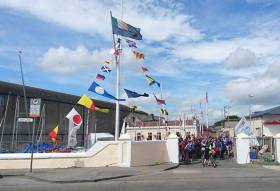Displaying items by tag: Sports Capital Grants
Irish Sailing Encourages Yacht Clubs To Spend Sports Capital Grant At Home
Irish Sailing is encouraging yacht and boat clubs who won over €1.1m in Sports Capital grants in November to try to spend the money in Ireland.
In the interests of 'supporting the Irish Boating industry', Irish Sailing has appealed to clubs to 'seek quotes from local suppliers and help to support the Irish Marine industry'.
Of the €1.1 million, awarded to clubs, Irish Sailing estimate approximately €750k will be spent on boats and equipment.
See the full list of clubs and awards as previously reported by Afloat.ie here
'The Sports Capital support for Irish Sailing clubs is brilliant for club development and creating new opportunities. If every club then bought from an Irish broker the knock on effect to the Irish marine industry would be tremendous' Irish Sailing CEO, Harry Hermon, told Afloat.ie.
'Our industry is a close knit community that offers an incredible support to the boating community – lets help keep the cogs oiled', he added.
30 sailing clubs throughout the country will share over a million in funding.
Dun Laoghaire's National Yacht Club on Dublin Bay is one of the biggest sailing club recipients with a grant of €142,375 for Increasing women and teenagers participation in the sport. The east pier club is the home of Rio Olympic silver medalist Annalise Murphy.
Also in Dun Laoghaire, the country's bggest sailing centre, the Irish National Sailing Club (Locaste) got €40,058 for the renewal of sailing equipment and the purchase of new boats.
The Royal St. George Yacht Club (RSGYC) got €31,228 for a Firefly dinghy renewal programme, Dun Laoghaire Motor Yacht Club got €18,515 for the purchase of a 5m RIB and capstan winch. The Royal Irish Yacht Club got €25,000 for its safety and support fleet. Dublin Bay Sailing Club got €11,236
Clontarf Yacht & Boat Club Benefits From 2017 Sports Capital Grants
#SailingGrants - Among the 30 Irish sailing clubs to benefit in the latest round of Sports Capital Grants is Clontarf Yacht & Boat Club, which was awarded €136,000 to increase equality of access with a new wet room and a much-needed extension of the women’s changing area.
“The allocation of this grant is great news for CY&BC,” said Commodore Andrew Semple. “We are a small volunteer based club who have worked over recent years to make sailing and water sports more accessible to all of the community.
“For the past several years we have run very successful ‘Gone Fishing’ days for our friends in the Central Remedial Clinic and St Michael’s House and we also host an annual Try Sailing event with the support of Irish Sailing to encourage more people to get on the water.”
“In the last few years we have also seen an additional number of women joining our club and participating in sailing and other events and our facilities have not matched the increased demand.”
“This vital funding will allow us to increase our equality of access with a new accessible wet room and a much needed expansion and refurbishment of the women’s changing rooms.”
Semple added: “As we are a small, volunteer-run club, this kind of financial support will have an incredible impact and help us invest in our future. We are grateful to Minister Richard Bruton TD, Minister of State Finian McGrath TD, and Seán Haughey TD for their support.”
CY&BC’s volunteers will be fundraising for the RNLI at the annual Christmas Day Swim later this month, as reported yesterday on Afloat.ie.
























